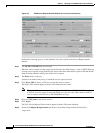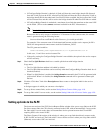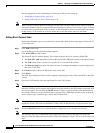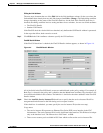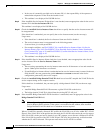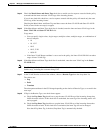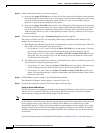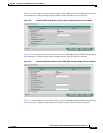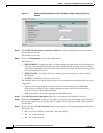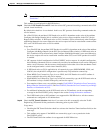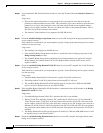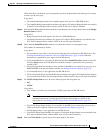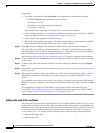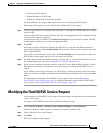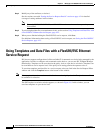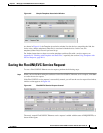
4-16
Cisco IP Solution Center L2VPN and Carrier Ethernet User Guide, 6.0
OL-21636-01
Chapter 4 Managing a FlexUNI/EVC Ethernet Service Request
Setting the Service Request Details
Figure 4-7 Standard UNI Details Window (Cisco ASR 9000, Configure Bridge Domain not
Enabled)
Step 23 The N-PE/U-PE Information and Interface Name fields display the PE device and interface name
selected in previous steps.
These fields are read-only.
Step 24 Choose an Encapsulation type from the drop-down list.
The choices are:
• DOT1QTRUNK—Configures the UNI as a trunk with 802.1q encapsulation. If the UNI belongs to
a directly connected and FlexUNI link, this setting signifies that the incoming frames are 802.1q
encapsulated and that they match the VLAN ID configured for the link. This specific topology does
not involve a trunk UNI as such.
• DOT1QTUNNEL—Configures the UNI as an 802.1q tunnel (also known as a dot1q tunnel or
Q-in-Q) port.
• ACCESS—Configures the UNI as an access port.
This attribute allows you to deploy different types of UNI encapsulation on different links of a service.
Usage notes:
• When a U-PE running with IOS is added in the same circuit terminating on an ASR 9000
(functioning in an N-PE role), the all three encapsulation types values will be visible in the
drop-down list of the Encapsulation attribute.
• DOT1Q TUNNEL is not directly supported for ASR 9000 devices.
Step 25 In the PE/UNI Interface Description field, enter a description for the interface, if desired.
Step 26 Check the UNI Shutdown check box if you want to leave the UNI port shut during service activation
(for example, when the service provider wants to deploy a service in the network but wants to activate it
at a later time).
Step 27 Specify the type of VLAN Translation for the service request by clicking the appropriate radio button.
The choices are:
• No—No VLAN translation is performed. (This is the default.)
• 1:1—1:1 VLAN translation.
• 2:1—2:1 VLAN translation.



